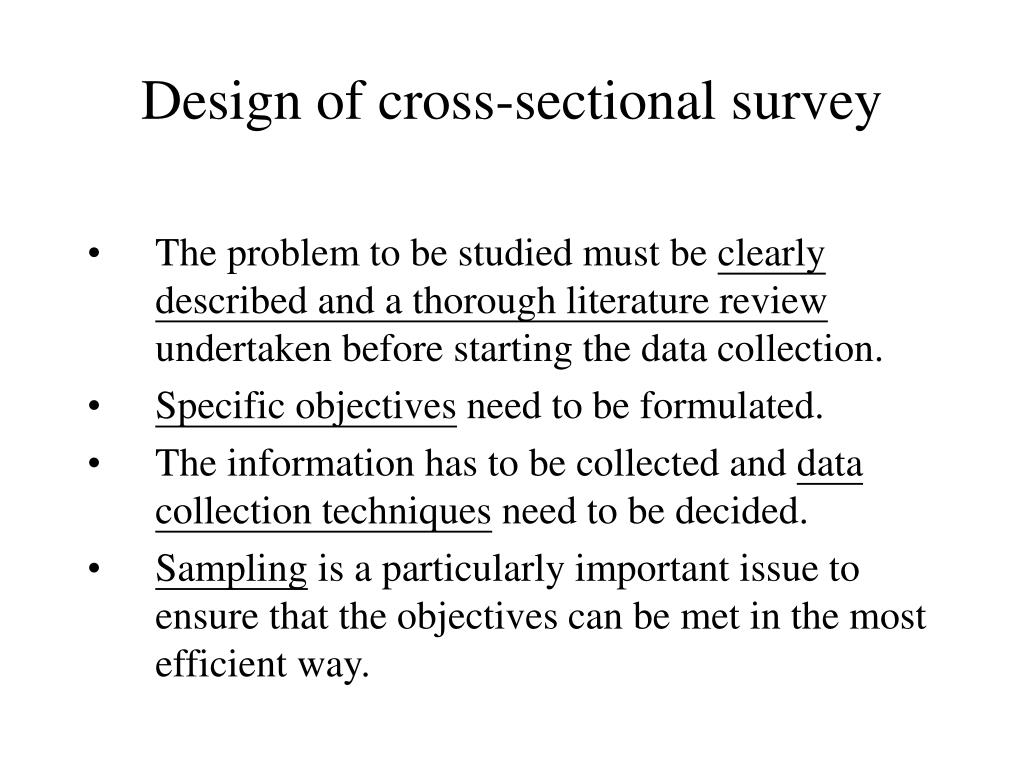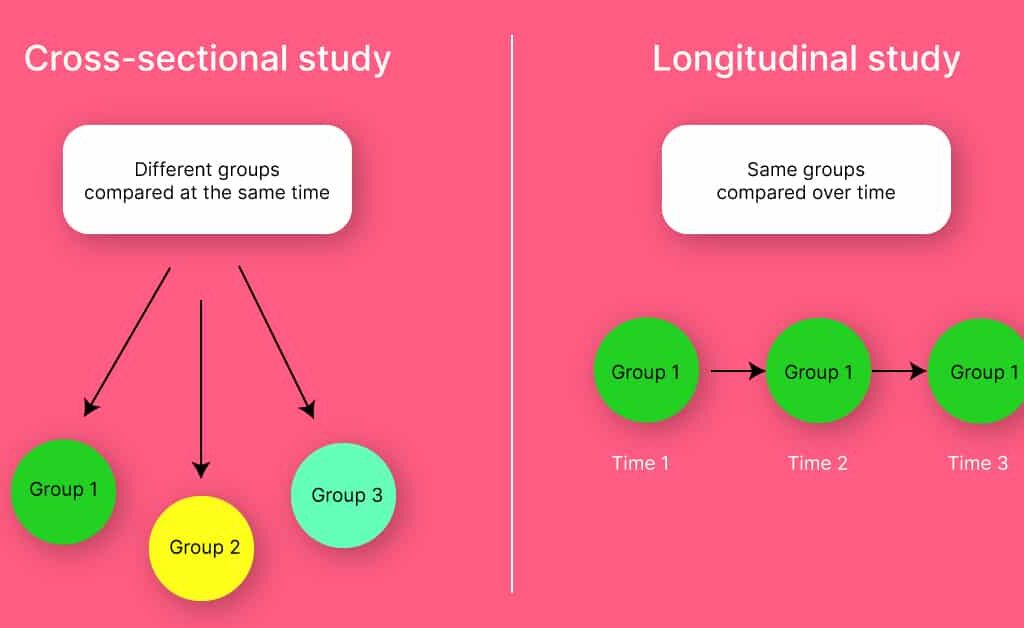Exploring Cross Sectional Study: A Comprehensive Guide with Examples
Table Of Content

Typically, however, they are only explicitly referred to as such when contrasted with longitudinal designs. Surveys and questionnaires about certain aspects of people's lives might not always result in accurate reporting. For example, respondents might not disclose certain behaviors or beliefs out of embarrassment, fear, or other limiting perception. A researcher might collect cross-sectional data on past smoking habits and current diagnoses of lung cancer, for example. While this type of study cannot demonstrate cause and effect, it can provide a quick look at correlations that may exist at a particular point.
Healthcare

Researchers might analyze various factors, including demographic information, behaviors, conditions, or outcomes, to discern patterns or correlations within the population studied. Cross-sectional studies are a fundamental research method used across various fields to analyze data at a specific point in time. By comparing different subjects without considering the time variable, these studies can provide valuable insights into the prevalence and characteristics of phenomena within a population.
Analytical Studies
Remember that while cross-sectional studies have their strengths, they also have limitations. They can't establish causation, and careful consideration of potential biases is crucial. But armed with the knowledge and guidance provided in this comprehensive guide, you're well-prepared to embark on your own research endeavors, contribute to your field, and make a meaningful impact on the world.
Frequently Asked Questions (FAQ)
Cross-sectional studies are a crucial tool in the repertoire of research methodologies, offering unique advantages that make them particularly suitable for various research contexts. These studies are instrumental in providing a snapshot of a specific point in time, which can be invaluable for understanding the status quo and informing future research directions. Below, we explore three significant benefits of employing cross-sectional studies in research endeavors. For example, a descriptive research study might catalog various health behaviors within a specific demographic group to inform public health initiatives. The primary goal is to describe characteristics, frequencies, or distributions as they exist in the study population.
It can be used to assess the prevalence of outcomes and exposures, determine relationships among variables, and generate hypotheses about causal connections between factors to be explored in experimental designs. For instance, an ecological association between higher income level and greater cardiovascular mortality across countries may be related to a higher prevalence of obesity. Third, migration of people between regions with different exposure levels may also introduce an error. A fourth consideration may be the use of differing definitions for exposure, outcome or both in different populations.
Sleep duration, hypnotic drug use, and risk factors: cross- sectional study Scientific Reports - Nature.com
Sleep duration, hypnotic drug use, and risk factors: cross- sectional study Scientific Reports.
Posted: Wed, 01 Mar 2023 08:00:00 GMT [source]
Descriptive cross-sectional studies
Researchers use this method to gather data efficiently and quickly, making it a valuable tool for assessing health, attitudes, behaviors, or characteristics. Cross-sectional studies can be useful research tools in many areas of health research. By learning about what is going on in a specific population, researchers can improve their understanding of relationships among certain variables and develop additional studies that explore these conditions in greater depth.
Those parts of the paper look at the relationship between different variables and thus qualify as having “analytical” cross-sectional design. Let us look at a study that was aimed to assess the prevalence of myopia among Indian children.[7] In this study, trained health workers visited schools in Delhi and tested visual acuity in all children studying in classes 1–9. Of the 9884 children screened, 1297 (13.1%) had myopia (defined as spherical refractive error of −0.50 diopters (D) or worse in either or both eyes), and the mean myopic error was −1.86 ± 1.4 D. Furthermore, overall, 322 (3.3%), 247 (2.5%) and 3 children had mild, moderate, and severe visual impairment, respectively. These data would be helpful to a health planner to assess the need for a school eye health program, and to know the proportion of children in her jurisdiction who would need corrective glasses.

Cross-sectional vs. longitudinal studies
The guideline is a tool investigators can use to develop their manuscripts and offers a checklist of inclusion items for a published paper (Equator.network). The recommended items will help ensure that a reader can understand the manuscript, follow the study’s planning and how the research was conducted, the findings, and the conclusions (von Elm et al., 2014). Furthermore, suppose the prevalence of a disease or phenomena is low, less than ten percent in the exposed and unexposed population (sample).
Cross-sectional research collects data on one sample at one point in time, whereas longitudinal research collects multiple datapoints over a longer period of time. The researcher(s) will collect data on various factors, all at the one time, and observe how those variables are related to other factors. These studies can map the prevailing variables that coexist at a specific point in time.
A matched cross-sectional study of the association between circulating tissue factor activity, immune activation and ... - BMC Infectious Diseases
A matched cross-sectional study of the association between circulating tissue factor activity, immune activation and ....
Posted: Fri, 17 Apr 2015 07:00:00 GMT [source]
The manufacturer now has the opportunity to conduct another market research survey. This time, he could ask the age group why they don’t use the soap for longer periods. The age group could be asked for suggestions on how to improve the soap to attract more customers like them. Introducing Appinio, the real-time market research platform that transforms the way you conduct cross-sectional studies. With Appinio, you can dive into the world of consumer insights, making it exciting and intuitive.
Each JBI Checklist provides tips and guidance on what to look for to answer each question. By diligently analyzing your data and effectively reporting and interpreting your results, you contribute to the body of knowledge in your field and facilitate evidence-based decision-making. Proper presentation and discussion of your findings ensure that your research has a meaningful impact on both academia and the broader community. You can also use this type of research to map prevailing variables that exist at a particular given point—for example, cross-sectional data on past drinking habits and a current diagnosis of liver failure. The people in that extended family are used to determine what is happening in real-time at the moment.
The approximate value of the point estimate is based on factors (i.e., characteristics like body weight, level of activity) such as the mean (average) of a population from a population’s random samples. The result shows that the obese HIV participants (exposed) were two and a half times (2.5x) more likely to be sedentary than the non-obese participants (unexposed). If the OR for the dataset was equal to 1, then the exposure (obese) did not affect the outcome’s odds. In other words, the chance of being sedentary is the same in the exposed (obese) and the non-exposed (not obese) groups.
Seamlessly integrate surveys, analyze responses, and gain valuable perspectives from diverse demographics with ease. A cross-sectional study is a type of research that collects data from a group of people at a single point in time to analyze characteristics and relationships. This study type is also known as cross-sectional analysis, transverse study, or prevalence study.
These studies often incorporate theoretical frameworks or models to analyze the data within a broader context, providing deeper insights into the underlying mechanisms or factors. Exploratory cross-sectional studies are conducted to explore potential relationships or hypotheses when little is known about a subject. By examining available data, they can generate hypotheses for further research without committing extensive resources to long-term studies. Though these studies cannot determine cause and effect, they are invaluable for generating hypotheses or propositions, informing policy decisions, and guiding future research. Their descriptive nature and relative ease of execution make cross-sectional studies a common starting point in many research endeavors, providing a foundational understanding of the context and variables of interest.
Case reports and case-series refer to a solitary patient or to only a few cases, who may represent a chance occurrence. Hence, conclusions based on these run the risk of being non-representative, and hence unreliable. The Framingham Heart Study, initiated in 1948, is a landmark cross-sectional and longitudinal study focused on cardiovascular health. It has played a pivotal role in identifying risk factors for heart disease, such as high blood pressure, high cholesterol, smoking, and obesity. The study has contributed significantly to developing preventive strategies and cardiovascular guidelines. A cross-sectional study (cross-sectional analysis or transverse study) offers an overview of a specific population in terms of an outcome at a given point in time.
Comments
Post a Comment